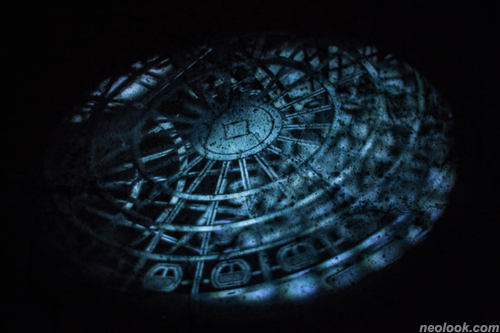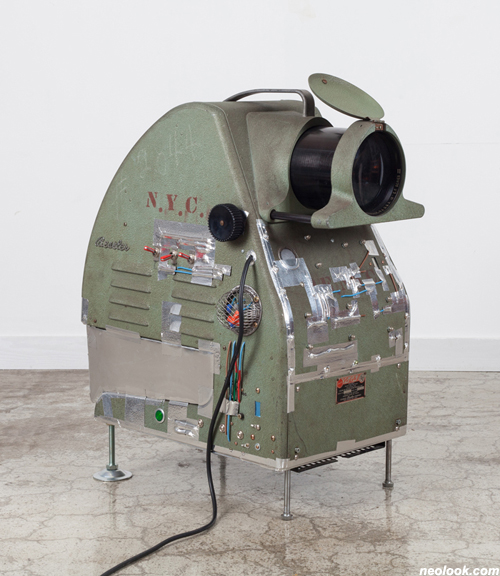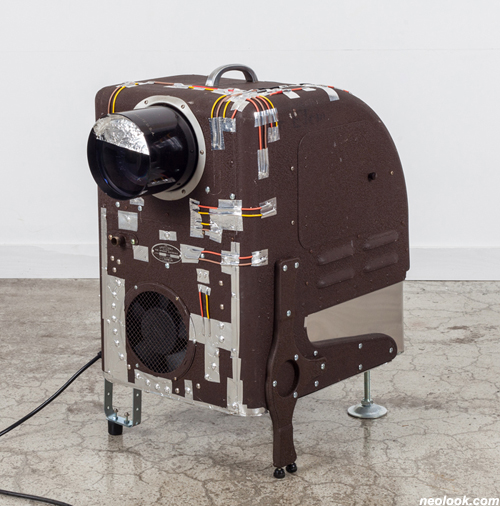- ● homepage
- ● archives
- ● restoration
- ● books
- ● big banners
- ● post board
- ■ neo's search
- ■ about us
- ■ 게재방법 안내
- 개인정보처리방침

- [email protected]
- Tel. 02_335_7922
- Fax. 02_335_7929
- 10:00am~04:30pm
- 월요일~금요일
- 3/3(월) 대체공휴일

신형섭展 / SHINHYUNGSUB / 申亨燮 / video.installation 2017_1014 ▶ 2017_1119 / 월,화요일 휴관
● 위 이미지를 클릭하면 네오룩 아카이브 Vol.20151211c | 신형섭展으로 갑니다.
초대일시 / 2017_1020_금요일_06:00pm
관람시간 / 01:00pm~06:00pm / 주말_12:00pm~05:00pm / 월,화요일 휴관
한미 갤러리 서울 Hanmi Gallery Seoul 서울 강남구 압구정로34길 30 Tel. 070.8680.3107 www.hanmigallery.co.uk
신형섭의 근작들- 라테르나 마기카의 진화 또는 미래 ● 「Cyclops-I」(2017), 「Cyclops-II」(2017), 「Cyclops-III」(2017) 등으로 이름 붙여진 신형섭의 근작들은 기본적으로 환등기를 활용한 영상작업이다. 이 때 '환등기', 곧 슬라이드 프로젝터는 삽입된 슬라이드 필름의 스틸이미지를 스크린에 확대하여 투사하는 아날로그 방식의 기계장치다. 하지만 신형섭의 「Cyclops」들은 환등기이긴 하지만 일반 환등기와는 확연히 구분되는 매우 특별한 기계장치다. 「Cyclops」들만이 지닌 고유한 특성들이 있다. ● 첫째는 환등기에 삽입된 것이 슬라이드필름이 아니라 오브제 자체라는 점이다. 신형섭은 환등기 내부를 개조하여 필름 이미지가 아니라 실제 오브제 이미지를 외부 스크린(벽면)에 투사하는 특이한 기계장치를 만들었다. 이를테면 우리는 「Cyclops」가 벽면에 투사한 반짝이 응원수술의 이미지를 볼 수 있다. 그것은 바람에 휘날린다. 흥미로운 것은 이 때 우리가 눈으로 보는 응원도구(응원수술)의 이미지가 회화(painting)나 영화(cinema)가 보여주는 이미지와는 영 다르다는 점이다. 일단 「Cyclops」가 투사한 이미지는 회화나 영화 이미지보다 훨씬 선명하다. 렌즈를 돌려 포커스를 맞출 수도 있다. 물론 그것은 선명하기만 한 것은 아니다. 그 이미지는 회화나 영화 이미지들보다 훨씬 더 '진짜'에 가깝다. 영화에서 눈으로 지각하는 움직임은 기본적으로 잔상(afterimage)을 이용한 눈속임 효과지만 「Cyclops」의 '움직이는 이미지'는 눈속임이 아니며 현실의 움직임을 나타내고 있다. 환등기 내부에 삽입된 오브제-응원수술은 회전하는 팬(fan)이 일으키는 바람 때문에 실제로 휘날리고 있는 것이다. 그러나 확실히 「Cyclops」가 보여주는 것은 실제 '응원수술'이 아니라 어디까지나 '응원수술의 이미지'라는 점에서 진짜에 가깝기는 하지만 진짜는 아닌 것이다. ● 그런 의미에서 신형섭의 「Cyclops」는 재현(representation)으로서의 이미지, 곧 현재(present)였던 것을 다시(re-) 현재이게끔(re-present) 하는 이미지의 본성을 거스른다. 그것은 확실히 '재현(再現)'이지만 '거의 현재'인 이미지에 해당한다. 그것은 사물의 이미지를 간접적(mediately)으로 보여주지만 사실상 거의 직접적으로(immediately) 보여준다. 그런 의미에서 「Cyclops」의 이미지는 지금까지 인류가 제작한 모든 이미지 가운데 가장 실재에 가까운(정직한), 그리고 가장 현재에 근사(近似)한 이미지를 제시하고 있다고 말할 수 있다. 지표(index), 흔적으로서의 아날로그 사진 역시 실재에 가깝다고 할 수 있지만 그것은 대개 현전(presence)보다는 부재(absence)의 감정을 산출한다는 점에서 현전의 느낌을 고양시키는 「Cyclops」의 수준에 미치지 못하는 것 같다.

- 신형섭_Argos Panoptes-I_기계장치, 조명, 렌즈_110×65×65cm_2017

- 신형섭_Argos Panoptes-I_기계장치, 조명, 렌즈_110×65×65cm_2017
이제 두 번째 특징을 말할 차례다. 「Cyclops」가 있는 전시장에서 관객은 벽면-스크린에 투사된 이미지뿐만 아니라 프로젝터 자체, 곧 이미지를 투사하는 기계 자체에도 집중하게 된다. 영화를 포함한 대부분의 영상작업에서 프로젝터는 감춰져 있다. 설령 눈앞에 노출되어 있더라도 그 가시성이 강조되기보다는 배제되기 마련이다. 즉 그것은 대개 눈앞에 있더라도 눈앞에 없는 것으로 여겨지기 마련이다. 하지만 「Cyclops」에서 기계장치-프로젝터는 유난히 눈에 들어온다. 신형섭이 택한 구식 미제(美製) 환등기 모델은 꽤 클 뿐만 아니라 생김새가 독특해서 우리의 시선을 잡아끈다. 따라서 신형섭이 연출한 전시장에서 관객은 벽면-스크린에 투사된 영상(이미지)뿐만 아니라 그 영상을 산출하는 기계에도 시선을 두게 될 것이다. 이 경우 우리는 벽면 이미지가 제공하는 환영(illusion) 또는 거울상(mirror image)에 좀처럼 몰입하거나 빠져들 수 없다. 아마도 우리는 이미지에 몰입하기보다는 산만하게 여기저기를 훑어보는 식으로 관람에 임할 것이다. 이런 관점에서 보자면 신형섭은 매체(기계)를 가시화함으로써 벽면 이미지가 진짜가 아니라 아무튼 이미지라는 것을, 즉 가짜라는 것을 끊임없이 일깨워준다.

- 신형섭_Argos Panoptes-I_기계장치, 조명, 렌즈_110×65×65cm_2017

- 신형섭_Cyclops-I_기계장치, 조명, 렌즈_70×40×50cm_2017
하지만 여기까지가 끝이 아니다. 세 번째 특징이 있다. 이것은 지금까지 관찰한 특성들과는 상반된 성격을 지니고 있다. 즉 신형섭의 작업에는 최대한 실재에, 현재에 접근하는 움직임이 있는가 하면 정반대의 움직임, 곧 비현실적인 가상세계를 촉발하는 움직임도 존재한다. 이를테면 신형섭이 개조한 프로젝터들을 살펴보면 그것은 프로젝터 자체가 아니라 자꾸 다른 것으로 보인다. 그것은 스타워즈에 나올 법한 로봇처럼 보이기도 하고 또는 그리스 신화에 나오는 눈이 하나인 괴물처럼 보이기도 한다. 신형섭이 붙인 "Cyclops"라는 명칭 자체가 그리스 신화에 나오는 외눈박이 괴물을 지칭한다. 여기서 한 걸음 더 나아가 신형섭은 「ARGOS Panoptes」(2017)라는 기계장치를 만들었다. 그것은 원리상 10개가 넘는 프로젝터가 하나의 몸체에 내장된 둥근 형태의 이미지 생산 기계다. 그 둥근 형태에는 10개가 넘는 구멍이 나있는데 그로부터 갖가지 오브제들의 이미지가 사방팔방으로 분출(투사)된다. ● 여기에 신형섭은 "ARGOS Panoptes"라는 명칭을 부여했는데 그것은 신화에 등장하는 눈이 100개 달린 괴물의 이름이다. 「ARGOS Panoptes」를 「Cyclops」가 진화한 형식으로 볼 수 있을까? 둥근 그릴을 개조해 만든 이 이미지 기계는 확실히 단순한 기계장치나 사물이 아니라 그 자체로 살아있는 뭔가-심지어 바퀴도 달려있다-로 보인다. 그러나 그것이 다른 뭔가로 보이는 것은 우리의 시선이 그 기계장치를 향할 때 발생하는 현상이다. 눈이 100개 달린 괴물보다 좀 더 강력하게 우리의 시선을 잡아끄는 것이 존재한다. 그것은 사방팔방에 투사된 오브제들의 이미지들이다. 환등기가 오래 전에 '라테르나 마기카 Laterna Magica' 곧 '마법의 빛'으로 불렸던 시대를 떠올려 볼 수 있다.

- 신형섭_Cyclops-I_기계장치, 조명, 렌즈_70×40×50cm_2017

- 신형섭_Cyclops-II_기계장치, 조명, 렌즈_70×40×50cm_2017
라테르나 마기카는 그 안에 들어있는 이미지를 내부의 빛을 이용해 외부의 평면에 투사하는 기계다. 17세기 물리학자 크리스치안 후이겐스(Christian Huygens), 토마스 발겐슈타인(Thomas Walgenstein) 같은 이들이 다양한 이미지들이 들어있는 유리판들을 연달아 겹치거나 교체할 수 있는 장치를 개발, 움직이는 이미지 효과를 연출하면서 널리 유행했다. 기계를 밀거나 당기는 식으로, 또는 렌즈를 조절하는 식으로 이미지를 변형할 수 있는 라테르나 마기카는 학술적인 목적으로 이용되기도 했으나 ● "유령을 불러내는" 장치로 유명세를 누렸다. 그리고 다시 신형섭의 「ARGOS Panoptes」를 보면 이 작품이 모든 방향-벽면, 천정, 바닥, 모서리 등-으로 내던진(project) 온갖 이미지들, 즉 배, 비행기, 철수세미 등의 이미지들은 먼 옛날 사람들을 두렵게, 또는 설레게 했을 판타스 마고리아(Phantas magoria), 곧 마술 환등의 세계로 우리를 인도한다. 「ARGOS Panoptes」는 라테르나 마기카의 가장 진화된 형식이 아닌가! ● 그런데 문득 누군가가 「ARGOS Panoptes」에 부착된 여러 스위치 가운데 하나를 켰다. 그러자 천장 위에 오르골이 등장하고 곧이어 연주가 시작된다. 아늑한 오르골 연주는 뭔가 모를 오싹한 분위기를 자아낸다. 다시 누군가가 다른 스위치를 켜자 이번에는 바닥에 돌아가는 배가 보인다. 그런데 그 스위치들이 보이자 곧 이어 여러 다른 것들이 보인다. 기계에 장착된 선과 계기판들, 빛이 새어나오는 것을 막기 위해 붙인 테이프 같은 것들이다. 이제부터는 눈이 100개 달린 괴물도, 미술 환등상의 세계도 대수롭지 않은 것으로 보인다. 이제 무엇과 만나게 될까? 거기에 테이프를 찢어 기계장치에 부착하고 있는 손이 보이는 것 같고, 두꺼운 그릴 뚜껑에 구멍을 뚫는 날카로운 소음이 들리는 것만 같다. ● 결국 마법은 사라지고 다시금 현실이 진짜 세계가 나타났다. 푸시킨(Aleksandr S. Pushkin)의 시에 등장하는 라테르나 마기카의 메타포는 "빛과 어둠, 타올랐다 꺼져버린 등불, 갑작스런 등장과 이해할 수 없는 소멸"을 나타낸다고 했는데 신형섭의 이 엉뚱한 기계장치가 불러일으키는 감정이 딱 그와 같지 않은가! ■ 홍지석

- 신형섭_Cyclops-II_기계장치, 조명, 렌즈_65×35×55cm_2017

- 신형섭_Cyclops-II_기계장치, 조명, 렌즈_65×35×55cm_2017
The latest work of Hyungsub Shin: The Evolution or Future of Laterna Magica ● The latest work of Hyungsub Shin, Cyclops-I (2017), Cyclops-II (2017), and Cyclops-III (2017), are essentially applications of the magic lantern. The magic lantern, otherwise known as the slide projector, is an analogue machine that enlarges still images of slide film and projects them onto a screen. Shin's Cyclops series are not just magic lanterns, but very special machines that are clearly different from normal slide projectors. They have their own distinctive traits. ● First, what is inserted in the magic lantern is not slide film, but the object itself. Shin converted the interior of the magic lantern and made a unique device that projects images of the actual object on the outside screen (wall), not the slide image. For instance, we can see the image of a glittering pom-pom on the wall projected by Cyclops. It sways by the wind. What is interesting is that the projected image of the pom-pom we see is quite different from the painted image or filmed image. The image projected by Cyclops is much clearer than painted images or filmed images. You can adjust the lens to focus. Of course, being clear is not the only difference. The image is much closer to the real object than painted or filmed images. Cinematic movement that our eyes recognize is basically the trick of afterimages [1], but the moving image of Cyclops is not a trick. It presents the movement in reality. The object inserted in the magic lantern (pom-pom) is swaying in real time by the wind coming from the fan. Nevertheless, what Cyclops shows is close to reality but not completely real, since it is not the actual pom-pom but the image of the pom-pom. In this context, Hyungsub Shin's Cyclops defies the nature of the image as a representation (re-present), which makes what used to be present become present again. It is clearly representation, or more precisely, an almost present image. It immediately shows the image of an object, or at least, almost immediately. In this sense, the image projected by Cyclops compared to all the images produced by mankind until today is perhaps closest to reality (frankness) and most similar to the present. Analogue photography, as an index or trace of reality, could also be close to reality, but it would not be at the level of Cyclops. The latter renders the feeling of presence while the former mostly emanates the feeling of absence rather than presence. ● Now let's talk about the second trait. In the exhibition space of Cyclops, the audience focuses their attention on the projector — not just the image projected on the wall (screen), but the device itself that projects the image. Projectors are hidden in most moving image artworks, including Cinema. Even though sometimes they are exposed, the projectors' visibility is rather downplayed, and not emphasized. In other words, it is treated as being non-existent although it is in front of our eyes. However, the machine — the projector — in Cyclops is highly visible. The old-fashioned American magic lantern Shin chose is not only quite large, but it also looks unique and catches our eyes. In the exhibition space Shin designed, the audience cannot help but notice the machine as well as the video (image) it projects on the wall (screen). In this case, we cannot easily be immersed in or concentrate on the illusion or projected image on the wall. Perhaps, we would appreciate the work by wandering around rather than being immersed in the images. In this perspective, by exposing the media (machine), Shin is constantly reminding us that the projected image is not real but just an image, or rather, a fake image. ● However, this is not all. Here is the third trait, which is opposite to the traits observed above. Shin's work shows movements that correspond to the real and the present as much as possible, and his work shows the opposite movement: the movement that conjures the unrealistic, virtual world. For example, the projectors Shin converted seem like something else, they are not merely projectors. They look like a robot from Star Wars or a one-eyed monster from Greek mythology. The name Shin chose, Cyclops, refers to the one-eyed monster in Greek mythology. Moreover, Shin created the machine named ARGOS Panoptes (2017). Essentially it is a circular image-producing machine equipped with more than 10 projectors inside its body. The circular form has more than 10 holes, which throw/project the images of various objects in all directions. [2] Shin named it ARGOS Panoptes after the name of the monster with 100 eyes in Greek mythology. ● Can we regard ARGOS Panoptes as the evolved form of Cyclops? Made by converting a round grill, the image-producing machine clearly looks like something alive as it is not merely a machine or an object(itevenhaswheels). However, what makes it look different is the phenomenon that occurs when we look at the machine. Something attracts our eyes more powerfully than the hundred-eyed monster. It is the images projected in all directions. We may refer to the age when the magic lantern was called Laterna Magica, otherwise known as magical light. Laterna Magica is a machine that uses its inside light to project the image on a screen outside. When physicist from the 17th century, such as Christian Huygens or Thomas Walgenstein, invented the device that can serially overlap or change sheets of glass that created the moving image effect, it became a popular machine. The Laterna Magica — a machine that transformed an image by pushing or pulling the machine or adjusting the lens — was used for academic purpose [3], but gained popularity as the device that called upon ghosts. And when we come back to Shin's ARGOS Panoptes, the images projected on all sides—wall, ceiling, floor, or corner— and, the images of ship, plane, or steel sponge all create the world of Phantasmgoria, which old people would have been afraid of. ARGOS Panoptes surely is the most evolved form of Laterna Magica! ● And, all of the sudden, someone turns on one of the many switches attached to ARGOS Panoptes. Then the music starts as a music box appears on the ceiling. The relaxed music stirs up a somewhat creepy air. When someone turns on another switch, a ship spins on the floor. When we see the switches, we quickly notice many other things: the lines and boards on the machine, or the tape used to block the light coming out of the machine. Then the hundred-eyed monster or the world of Phantasmagoria seems insignificant. Then what would we encounter? We would imagine the hands that cut the tape and put it on the machine, or the sharp sounds of drilling holes on its thick grill cover. At last, the magic fades away, and the real world appears again. The metaphor of Laterna Magica in the poetry of Aleksandr S. Pushkin was "light and darkness, a lamp that lighted up and failed, sudden appearance and bizarre extinction." And, isn't it exactly the same feeling that Hyungsub Shin's extraordinary machine triggers? ■ Ji-suk Hong
Vol.20171014f | 신형섭展 / SHINHYUNGSUB / 申亨燮 / video.installation

